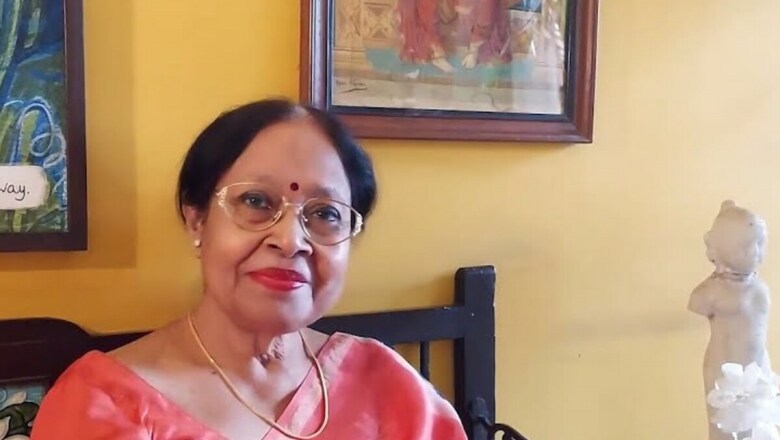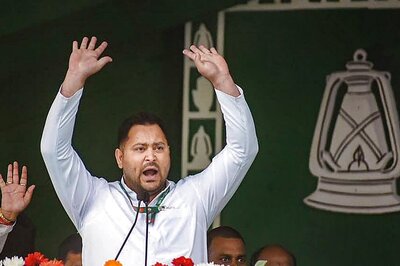
views
Critically acclaimed author and translator Aruna Chakravarti has been monumental in terms of her dedication and participation in working with Bengali literature and Indian English literature in contemporary times. The academician who retired as the principal of Janki Devi Memorial College has translated the works of Rabindranath Tagore, Saratchandra Chattopadhyay, Sunil Gangopadhyay and many more from Bengali to English in order to make them approachable to a broader range of audience. From the Sahitya Akademi Award to the Sarat Puraskar and to even being shortlisted for the Commonwealth Writers’ Prize for her debut novel, Chakravarti has been honoured with several accolades for her literary contributions.
In an exclusive interview with NW18, Aruna Chakravarti talks about her journey as a writer and a translator, her works and the influence of Rabindranath Tagore in her life.
Only a few dare to venture into the field of literary translations. When and how did you think you could set foot into it?
My first published work, a collection of lyrics culled from Rabindranath Tagore’s Gitabitaan and translated into English, appeared in 1884. My entry into the world of translation happened quite by accident. I was participating in a Rabindra sangeet presentation in Mumbai, in 1882, when a Gujarati gentleman from the audience requested a translation of the songs we were singing. I was extremely timid and self-conscious those days but somehow got persuaded to do it. The rendering sounded good even in my ears. By the end of the evening, I received a commission from the organizers of the programme for an anthology of Tagore’s lyrics in English translation which they would publish.
You wrote your first novel in your fifties and over time and again you have mentioned how Sunil Gangopadhyay pushed you into getting back to the creative writing genre. Can you please talk a little about that?
After that, I translated Saratchandra Chattopadhyay, Sunil Gangopadhyay, Tarashankar Bandopadhyay and many more authors. It was Sunil Gangopadhyay, and my own family members of course, who kept persuading me to try my hand at creative writing. But it was a young man interviewing me for Desh Patrika who turned the push into a hard shove. In the interview, he asked me if I ever intended to take up creative writing. Not wanting to sound negative I said I may do so, sometime, in the future.
He then asked me what I thought I would write, and I answered it might, just might, be a novel based on the lives of my ancestors. When the interview was published, I saw, to my horror, that his last line was Aruna Chakravarti’s next project is a novel about her ancestors. The news spread like wildfire. Congratulations and messages approving the decision came pouring in. What option did I have left? This was how The Inheritors came to be written.
Not just Rabindranath Tagore but rather the entire Tagore family has influenced you and has been your muse which we get to see in two of your very popular writings, ‘Jorasanko’ and ‘Daughters of Jorasanko’. It was a mammoth task to unearth so much history. Can you take us through the process? How much of your writing was based on facts and how much of it was fiction?
Yes. Rabindranath has been a major influence in my life as he is in the lives of most Bengalis. My interest in the women of the Tagore household came later. From my childhood, I was keen to learn about the women of Bengal because one only heard about its extraordinary men. I was convinced that there were some great women, too, whom patriarchal dominance had kept out of the limelight. When I began researching, I found that many women had contributed to the societal changes that came in the wake of the Bengal Renaissance and its aftermath. But since it was not possible to write about them all I had to narrow my focus. Gradually I zoomed in on the Tagore women and I wrote two books about them. Yes, it involved a good deal of research.
Coming to the latter part of your question, how much was fact and how much fiction, it is very difficult to put a quantum to either. The events presented are historically accurate and documented. Even the dates are authentic. But books are not history. They are novels; imaginative reconstructions of the lives of women in the wealthy, forward-thinking, enlightened Tagore household. The more I researched, the more puzzled I became. I found a world, glamorous and glittering on the surface but dark and challenging beneath. Particularly for women.
That is when I decided to add a fictional component which gradually suffused the work to a degree greater than the factual one. My imagination took flight, and I got immersed in their lives. What did these women think and feel? What dreams did they dream? What sorrows did they keep hidden in their breasts? I tried to enter the deepest recesses of their psyches. I was haunted by them.
In all your writings there is a constant effort by you to take the reader on time travel. How do you manage that?
Yes, for some reason I cannot fathom, I tend to write about the past. Bygone eras beckon to me in a way that the present never does. I suppose it’s because when I am travelling on time, I am able to maintain a certain distance between myself and my subject. I can see the world I am reconstructing with clear, unbiased eyes. Objectivity is not possible when dealing with the present. The ties are too close and intrusive.
As for how I manage it, it starts with a lot of research. I have, as well, to do a lot of thinking. Somewhere in the process, the imagination takes over and a world is revealed. I find myself getting more and more immersed in that world. It gets to a point sometimes when I ask myself. Is what I have written based on something I have read somewhere, or have I imagined it?
You have always chosen to write about extremely strong women in your books, may that be in ‘Daughters of Jorasanko’ or ‘Suralakshmi Villa’. Is that a conscious choice?
I wouldn’t say that it was a conscious choice to write about strong women. In the Tagore household, there were many women who were path breakers. Digambari forbade her husband entry into his own home because she believed he had strayed from the moral path. Jogmaya refused to obey her brother-in-law’s diktat and the entire family embrace the Brahmo faith. This resulted in a rift that divided the Tagores into two branches– Hindu and Brahmo. Tripura sundari refused to give up her husband’s share of the property and even fought a court case against the doughty Debendranath. Jnanadanandini introduced many changes in the way the women of the household lived; changes that spread to the rest of Bengal. These were real people and their actions are documented. Naturally, they would be presented as they actually were in the novel.
Suralakshmi is a fictional character, and she is strong. So is her mother. But there are some women in my novels who might be deemed weak. Kadambari and Bibhavati for instance. They are wonderfully sensitive women, with a fineness to their characters that isn’t found in the so-called strong women. But they didn’t or couldn’t fight for their rights and had tragic endings.
You will be speaking at the Jaipur Literature Festival, in January of 2023. How do you feel and what is in store for the audience?
My new book The Mendicant Prince is to be discussed at the Jaipur Literature Festival 2023. This is another historical novel; an imaginative reconstruction of a prominent legal case fought in the dwindling twilight of British India. The fictional component provides the ambience and sheds light on the lives of the people affected by it. Particularly the women of the family through whose voices the story is told, to a large extent. Since nothing is known about these women, I had to give them imaginary backgrounds, personalities, and distinguishing characteristics. I had an exciting time writing the book and I am looking forward to the discussion which, I’m sure, will also be exciting.
Read all the Latest Lifestyle News here




















Comments
0 comment